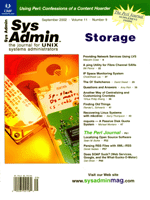 syslog syslog
The 19th Top 500 Supercomputer list was released at the International
Supercomputer Conference (ISC2002 in Heidelberg) in June of this
year. Since the previous list came out 6 months prior, there've
been quite a few changes in the supercomputing world.
Performance of machines on the Top 500 list is measured with the
Linpack benchmark. The benchmark involves solving a system of linear
equations. According to the Top 500 Web site, "For the Top
500, we used that version of the benchmark that allows the user
to scale the size of the problem and to optimize the software in
order to achieve the best performance for a given machine. This
performance does not reflect the overall performance of a given
system, as no single number ever can. It does, however, reflect
the performance of a dedicated system for solving a dense system
of linear equations. Since the problem is very regular, the performance
achieved is quite high, and the performance numbers give a good
correction of peak performance." A detailed description of
the benchmark, as well as a list of performance results for a wide
variety of machines, is available from Netlib. A parallel implementation
of the Linpack benchmark, and instructions on how to run it, can
also be found at: http://www.netlib.org/benchmark/hpl/.
The number one spot on the Top 500 list is now occupied by the
Japanese Earth Simulator. The Earth Simulator is based on the NEC
SX architecture and has 640 nodes -- each node with 8 vector
processors (8 Gflop/s peak per processor), 2 ns cycle time, and
16 GB shared memory. It has a total of 5104 total processors, 40
TFlop/s peak, and 10 TB memory. For comparison, the Japanese Earth
Simulator's performance equals the sum of the Linpack performance
of the next 12 systems on the list. According to the Web site, it
leads number two on the list (IBM-built ASCI White at Lawrence Livermore
National Laboratory) by a factor of almost 5 in Linpack performance.
There are three other new systems in the Top 10, as follows:
- At #4 is a Hewlett-Packard AlphaServer (with 4 Tflop/s) installed
in France at the Commissariat a l'Energie Atomique (CEA).
- At #8 is an IBM Power4 system (with 2.3 Tflop/s) installed
at Oak Ridge National Laboratory.
- At #10 is a similar IBM system (with 2 Tflop/s) currently tested
at Poughkeepsie for shipment to the U.S. Army Research Laboratory
(ARL).
Note that to be on the list at number 500 requires at least 134
Gflop/s. Six months ago, 134 Gflop/s would have gotten you almost
half way up the list to number 280. Also:
- Two Tflop/s Linpack performance are needed to enter the Top
10.
- Five of the Top 10 systems are from IBM, three are from HP,
one from NEC, and one from Intel.
- Although IBM has the most systems in the Top 10 (5), Hewlett-Packard
has the most in the whole list (168).
- Only 23 machines in the world exceed 1 Tflop/s of Linpack performance.
More than 10% of the systems on the list now consist of cluster
machines. The fastest of these is an AMD Athlon-based system (at
number 35), located at the University of Heidelberg. You can see
the entire new Top 500 list at: http://www.top500.org/list/2002/06/.
(Information for this column was taken from the Top 500 Web site
at: http://www.top500.org.)
Sincerely yours,
Amber Ankerholz
Editor in Chief
|

